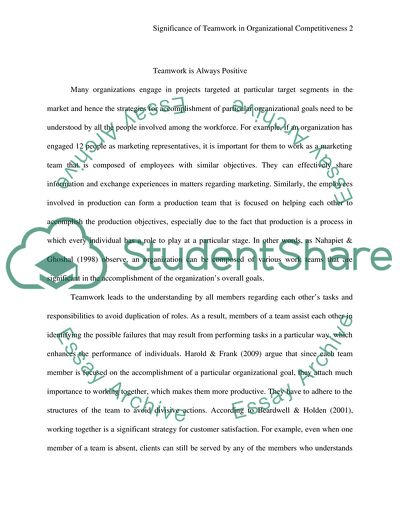Cite this document
(“Significance Of Teamwork In Organizational Competitiveness Case Study - 1”, n.d.)
Significance Of Teamwork In Organizational Competitiveness Case Study - 1. Retrieved from https://studentshare.org/human-resources/1731248-the-research-challenges-the-view-that-identification-with-the-team-or-the-customer-is-always-positive-critically-evaluate-the-view-that-teamwork-is-always-positive-illustrate-your-arguments-with-examples-from-uk-us-organizations-and-contrast-this
Significance Of Teamwork In Organizational Competitiveness Case Study - 1. Retrieved from https://studentshare.org/human-resources/1731248-the-research-challenges-the-view-that-identification-with-the-team-or-the-customer-is-always-positive-critically-evaluate-the-view-that-teamwork-is-always-positive-illustrate-your-arguments-with-examples-from-uk-us-organizations-and-contrast-this
(Significance Of Teamwork In Organizational Competitiveness Case Study - 1)
Significance Of Teamwork In Organizational Competitiveness Case Study - 1. https://studentshare.org/human-resources/1731248-the-research-challenges-the-view-that-identification-with-the-team-or-the-customer-is-always-positive-critically-evaluate-the-view-that-teamwork-is-always-positive-illustrate-your-arguments-with-examples-from-uk-us-organizations-and-contrast-this.
Significance Of Teamwork In Organizational Competitiveness Case Study - 1. https://studentshare.org/human-resources/1731248-the-research-challenges-the-view-that-identification-with-the-team-or-the-customer-is-always-positive-critically-evaluate-the-view-that-teamwork-is-always-positive-illustrate-your-arguments-with-examples-from-uk-us-organizations-and-contrast-this.
“Significance Of Teamwork In Organizational Competitiveness Case Study - 1”, n.d. https://studentshare.org/human-resources/1731248-the-research-challenges-the-view-that-identification-with-the-team-or-the-customer-is-always-positive-critically-evaluate-the-view-that-teamwork-is-always-positive-illustrate-your-arguments-with-examples-from-uk-us-organizations-and-contrast-this.


